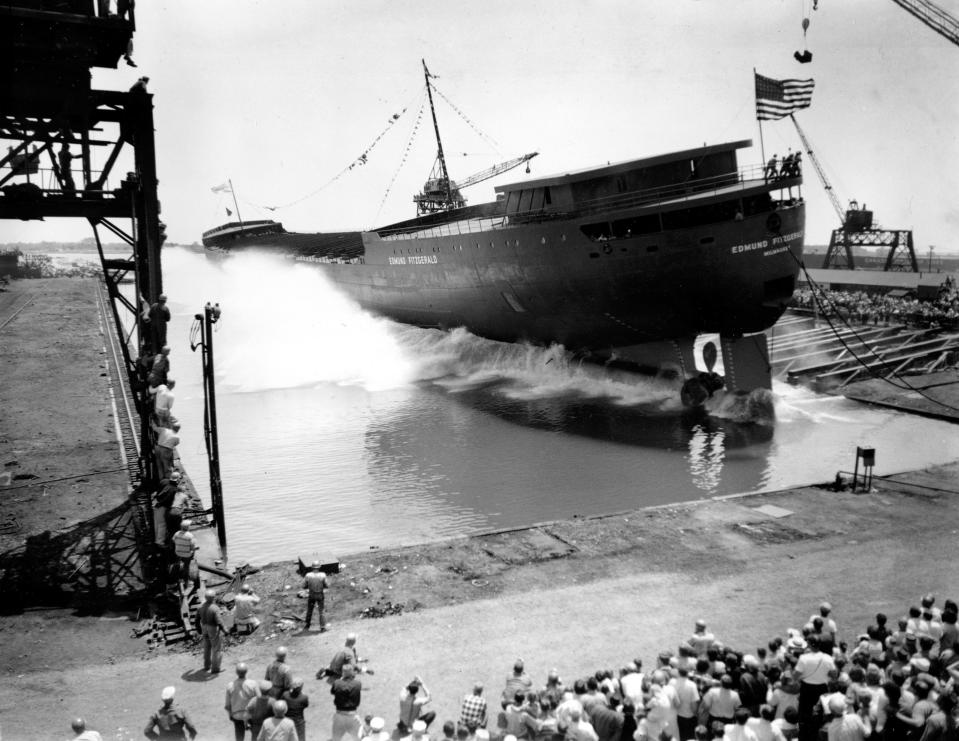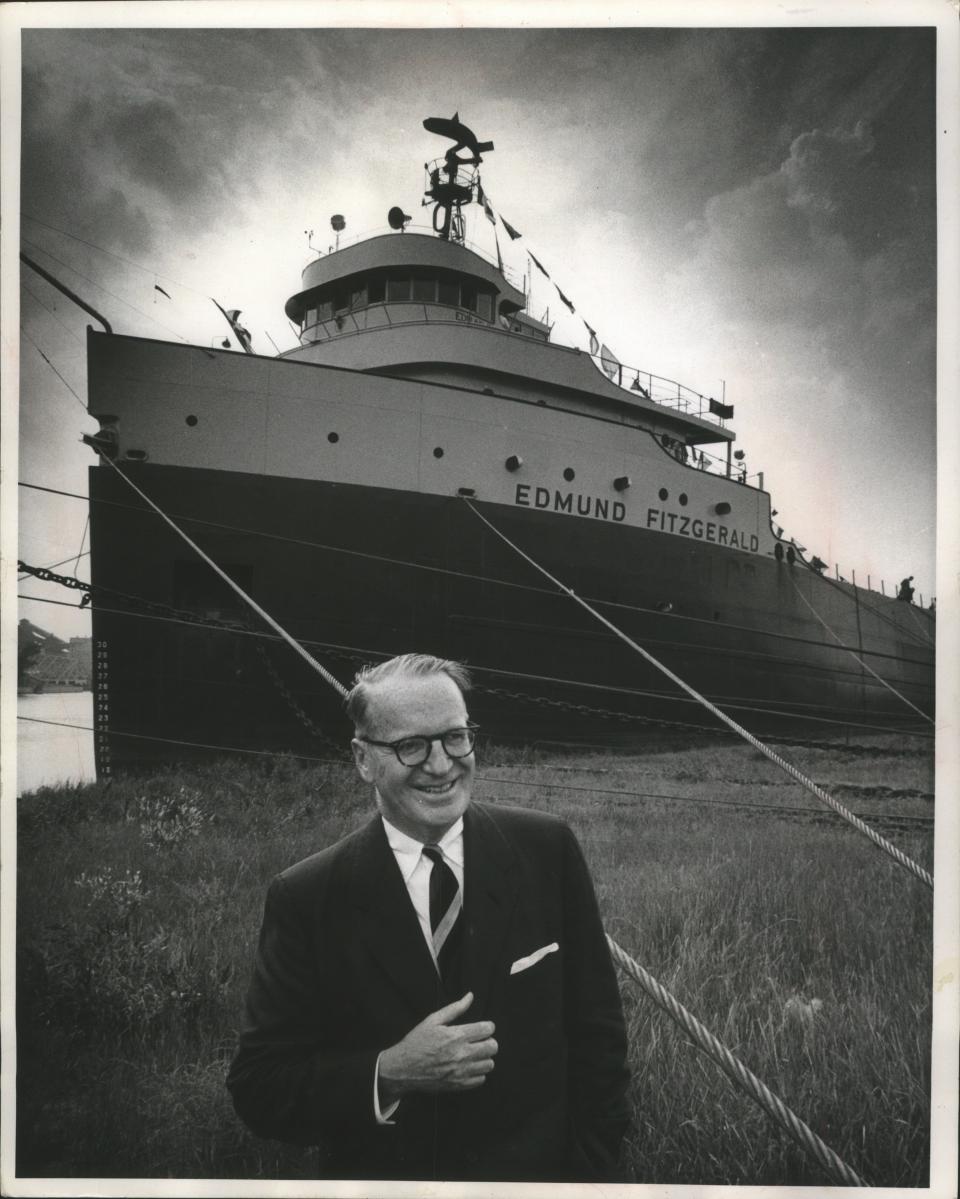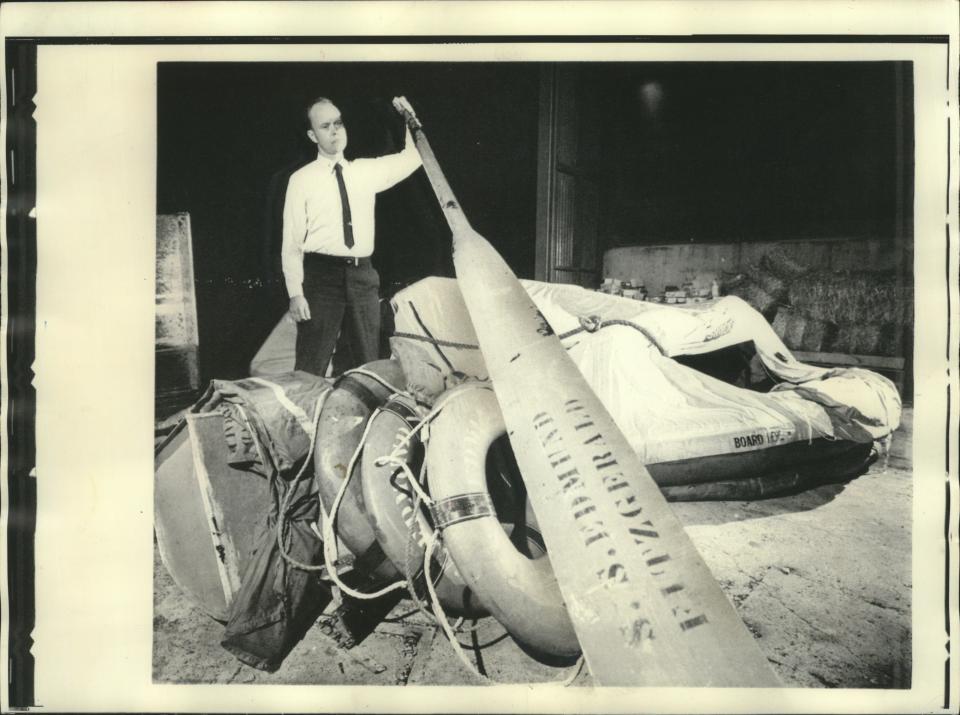What you should know about the Edmund Fitzgerald, the Milwaukee-linked ship that sank and inspired a classic Gordon Lightfoot song
- Oops!Something went wrong.Please try again later.
One of the best-known shipwrecks of the 20th century took place north of Wisconsin involving a ship owned by a Milwaukee company, registered to Milwaukee and named for a Milwaukee board chairman — and which became a legend thanks to a haunting song about the tragedy by Canadian singer-songwriter Gordon Lightfoot.
Here's what you should know about the SS Edmund Fitzgerald.
What was the Edmund Fitzgerald?
The SS Edmund Fitzgerald was an ore carrier that, when it was launched in June 1958, was the largest ship on the Great Lakes. Costing $8 million to build, the 729-foot-long ship was designed to haul taconite iron ore from mines in Duluth, Minnesota, to iron works in port cities around the Great Lakes. Although it was launched in River Rouge south of Detroit, Milwaukee was its port of registry. (At the time of the launch, The Milwaukee Journal called the Edmund Fitzgerald "the new queen of the Great Lakes ore fleet.") The Edmund Fitzgerald was a hard worker, setting seasonal hauling records six times; in 1972, the ship set a single-haul record carrying more than 30,000 tons of iron pellets, a record later broken by much larger ships.

Who was the Edmund Fitzgerald named for?
The SS Edmund Fitzgerald was built by Milwaukee-based Northwestern Mutual Life Insurance Co. Reportedly, the ship was the first such investment by an American insurance company; at the time, the insurance giant had a lot invested in the iron and minerals industries.
The ship was named for the company's then president and chairman of the board, Edmund Fitzgerald. Fitzgerald came from a nautically minded family — his father owned a ship-repair company, and his grandfather was a ship captain — and was one of the founders of the Wisconsin Marine Historical Society.
Fitzgerald also was a civic leader actively involved in the rush of postwar improvements in Milwaukee. According to his obituary in The Milwaukee Journal in 1986, he "had a hand in almost every major improvement in town during the 1950s, '60s and '70s," especially the Marcus Performing Arts Center, the Port of Milwaukee, and the downtown central post office and Amtrak station. (His son, Edmund B. Fitzgerald, followed in his footsteps; as CEO of manufacturing giant Cutler-Hammer, he was a key player in the group that brought Major League Baseball back to Milwaukee with the Milwaukee Brewers in 1970.)

Why did the Edmund Fitzgerald sink?
On Nov. 10, 1975, the Edmund Fitzgerald was sailing across Lake Superior and loaded with more than 26,000 tons of taconite ore pellets when it ran into a storm packing 70-knot winds and producing 25-foot waves. The ship reported that it had some topside damage, including the loss of two vents and some fence rail, and that the ship was listing and dealing with flooding — but it did not issue a distress call.
The ship sank in Canadian waters, about 17 miles northwest from the entrance to Whitefish Bay (in Lake Superior, not the Whitefish Bay in Milwaukee's North Shore). All 29 men on the ship perished; their bodies were never recovered. The ship sank so fast that the crew didn't have time to lower lifeboats, although reports indicated that it would have been difficult to do so in such stormy waters.
Speculation about why the ship sank has ranged from structural failure to rogue waves; in its findings on the sinking, the U.S. Coast Guard's Marine Board of Investigation report said that the "most probable cause" of the sinking of the Edmund Fitzgerald was "the loss of buoyancy and stability which resulted from massive flooding of the cargo hold." But the report did not make any definitive conclusion on the cause.

Has the wreck of the Edmund Fitzgerald been recovered?
Surveys by air and sonar not long after the sinking found the wreckage of the ship, which appeared to have broken in two. A number of dive teams, some of them unmanned, investigated the wreckage in the three decades after the sinking, recovering parts of lifeboats and other debris. In 1995, the ship's 200-pound bronze bell — a largely ceremonial piece required by the Coast Guard at the time — was recovered and taken to the Great Lakes Shipwreck Museum in Whitefish Point, Michigan, not far from where the Edmund Fitzgerald sank. But in 2006, an amendment to the Ontario Heritage Act declared the shipwreck a protected marine archaeological site, effectively barring expeditions and diving to the ship.
Why did Gordon Lightfoot write 'Wreck of the Edmund Fitzgerald'?
Gordon Lightfoot got the inspiration to write "Wreck of the Edmund Fitzgerald" after reading an article on the ship's sinking in the Nov. 24, 1975, issue of Newsweek magazine. In an interview with the Journal Sentinel's Bill Glauber in November 2015, just before the 40th anniversary of the tragedy, Lightfoot said he thought the article "was too short, too brief," and that those who lost their lives on the Edmund Fitzgerald deserved more.
"I didn't want it to be forgotten," Lightfoot said.
The lyrics borrowed directly from the first line in the Newsweek article: "According to a legend of the Chippewa tribe, the lake they once called Gitche Gumee 'never gives up her dead.'"
The song's first verse:
The legend lives on from the Chippewa on down
Of the big lake they called "Gitche Gumee."
The lake, it is said, never gives up her dead
When the skies of November turn gloomy.
With a load of iron ore twenty-six thousand tons more
Than the Edmund Fitzgerald weighed empty,
That good ship and true was a bone to be chewed
When the "Gales of November" came early.
The shanty-style song came together quickly, and was recorded — reportedly, in one take — about a month after the sinking. Released the next summer, "Wreck of the Edmund Fitzgerald" made it to No. 2 on the Billboard Hot 100 chart, and was a staple of Lightfoot's live performances for decades after.

"It is a very good piece of work, I do believe," Lightfoot told the Journal Sentinel in 2015. "It's just one of those songs that just stands the test of time and it's about something that, of course, would be forgotten very shortly thereafter, which is one of the reasons I wrote the song in the first place. I didn't want it to be forgotten."
Lightfoot died on May 1, 2023, at age 84.
Editor's note: An earlier version of this story incorrectly said the Edmund Fitzgerald was launched in Detroit.
This article originally appeared on Milwaukee Journal Sentinel: What to know about the Edmund Fitzgerald, whose wreck inspired song

